
Original Link: https://www.anandtech.com/show/399
Intel Pentium III E "Coppermine" (Slot-1)
by Anand Lal Shimpi on October 25, 1999 7:21 PM EST- Posted in
- CPUs
The AMD Athlon.
Those three words meant the loss of the performance throne for Intel. All of the sudden the name that was associated with low-cost, budget or poor gaming PCs now held a new definition. There was no arguing the fact that AMD’s Athlon was the fastest desktop x86 processor on the market. But was this really the first time?
In terms of overall performance, it has been a long time since we’ve been able to say that about an AMD processor, but time and time again AMD has taken the performance throne away from the mighty Intel.
Remember the K6? Upon its release AMD provided Intel with some very serious competition to their Pentium MMX and, in some cases, their Pentium Pro line of processors.
Remember the K6-2? Back in 1998 the initial benchmarks of the K6-2 had it beating an equivalently clocked Pentium II in Quake 2.
And how can we forget the K6-3? In December of that same year we took a look at the performance AMD’s K6-3 offered and watched it give new meaning to the performance we had come to expect from the Super7 platform.
With all of those successes under their belt, why aren’t we seeing AMD-inside commercials on TV?
A month after the release of the K6, Intel retook the throne with the release of the Pentium II. After E3 in 1998, Intel released the Pentium II 400 at a performance level AMD’s K6-2 333 could not compete with across the board. And in February, Intel outpaced AMD once again in the clock speed lane by releasing the Pentium III 500.
Just like a tennis match, the two companies have been serving products back and forth with hopes that the other player would screw up eventually. The ball was last in AMD’s court and they returned it with so great of a force that the laughable release of Intel’s Pentium III 533B and 600B couldn’t even hope to stop it.
The ball is in Intel’s court and it’s their turn to serve; should AMD be worried? Not incredibly, as they still have a few fingers on the performance throne. But AMD should definitely beware since the other fingers on the throne now belong to Intel.
0% Copper
Intel’s latest addition to the Pentium III line of processors is what we’ve referred to as the "Coppermine" CPU. Coppermine is one of Intel’s many codenames for pre-production processors and doesn’t mean that the processor is based on copper technology.
0.18-micron core
The differences between the Pentium III E and all previous Pentium III CPUs begin with the new 0.18-micron core. All previous Pentium III CPUs were manufactured on the 0.25-micron fabrication process.
The good news is that the transition from 0.25-micron to 0.18-micron is going very smoothly. Part of the reason for this is because Intel started the transition to 0.18-micron very early on. On June 14, 1999, Intel released their first 0.18-micron CPU, the mobile Pentium II 400. The CPU featured 256KB of on-die L2 cache operating at clock speed which helped bring up the total transistor count to 27.4 million transistors for a single mobile chip. Why does this matter?
Intel has a history of trying out technologies on their mobile parts before bringing them to desktops. At the time the 0.18-micron mobile Pentium II 400 was produced, it wouldn’t have been profitable for Intel to shift their entire production line to 0.18-micron for desktop CPUs. The beauty of mobile chips is that the demand for them isn’t nearly as great as desktop CPUs, so Intel doesn’t have to manufacture as many. This way, they can try out a new manufacturing process on a few CPUs, work towards perfecting it, and then eventually apply it to the bulk of their sales -- desktop CPUs.
The production of the mobile Pentium II 400 went very well and Intel is planning to ramp up production of their 0.18-micron desktop CPUs faster than they have ever done in the past. This is in no way a bad thing, 0.18-micron chips are cheaper to produce and allow more CPUs to be produced per wafer than on the 0.25-micron process.
Intel has four of their fabrication plants primed and ready for the transition to 0.18-micron. By the end of Q1-2000 Intel predicts that half of their Pentium III processors will be the new 0.18-micron Pentium III E chips with that percentage climbing to 100% by the end of next year.
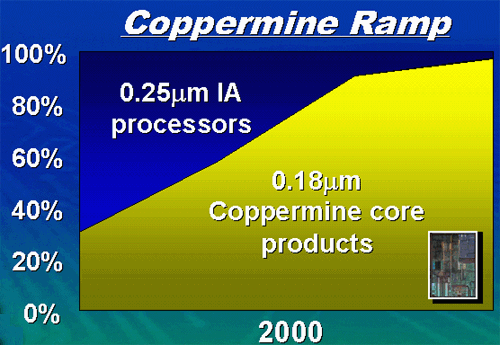
Intel is obviously planning on manufacturing the Pentium III E in significant volumes and they have already set a goal for 8xxMHz in the first quarter of the next year.
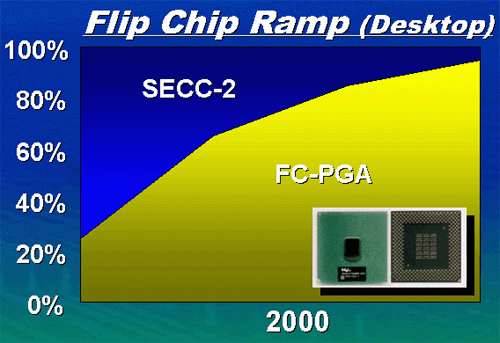
The 0.18-micron process will also allow for the eventual transition to cheaper socketed CPUs in the year 2000. At the launch of the Pentium III E, only two socketed CPUs will be made available (Pentium III 500E & Pentium III 550E) but by the middle of 2000 over half of all desktop Pentium III E CPUs will be socketed. The cost of producing these socketed, or Flip Chip PGA (FC-PGA) as they are technically known, chips is noticeably less than the cost of producing a Slot-1 SECC2 cartridge chip.
The 0.18-micron core also means quite a bit as far as overclocking potential is concerned. Our 733MHz sample had a nice time hovering around 800MHz and as Intel perfects their 0.18-micron process you can expect these CPUs to become very nice overclockers since they already run so very cool. We will be taking a closer look at the overclocking potential of the 0.18-micron process in the coming weeks.
256KB L2
The most noticeable difference between the Pentium III E and all previous Pentium III processors is that the Pentium III E features a full 256KB of on-die L2 cache operating at clock speed. This not only helps the platform scale better as clock speed increases but it also improves performance across the board.
For those of you that aren’t familiar with the function of L2 cache, it is best summarized as a small amount of high speed memory. When storing data, the first place the CPU would like to have it stored would be on the chip itself, so that the CPU does not have to cross any slower busses to retrieve the data. The data can’t be stored just anywhere on the physical chip, it needs to be stored in some sort of memory location; this is cache.
Let’s split the cache into two parts, the first, a small but extremely fast cache, and the second, a cache that’s larger but slower, but still faster than the system memory that the CPU would otherwise have to use to storeand retrieve its data from. Let’s call these two caches L1 and L2 respectively.
The Pentium III processor (not the Pentium III E) features 32KB of L1 cache and 512KB of L2 cache. The L1 cache operates at the clock speed of the CPU (i.e. 500MHz) and the L2 cache operates at half the clock speed of the CPU.
As you can see, 32KB is not a lot of space to store data, so only a very small amount of information can be stored in the Pentium III’s L1 cache. What doesn’t fit into its L1 can potentially go to the L2. While the L2 cache is obviously slower (in this case, 250MHz vs 500MHz) than the L1 cache, it is still faster than the system memory, which runs at anywhere from 66 – 133MHz depending on your system; in this case it would be running at 100MHz.
The Celeron processor features 32KB of L1 cache and 128KB of L2 cache. In this case, both the L1 and L2 cache operate at the clock speed of the CPU (i.e. 500MHz).
With these two processors, applications that can fit within the 128KB L2 cache of the Celeron will run faster on the Celeron 500 than they would on the Pentium III 500, because the L2 cache of the Celeron is running at twice the speed of the L2 cache of the Pentium III (500MHz vs 250MHz).
At the same time, if you had an application that could not fit within the 128KB L2 of the Celeron but it could fit within the 512KB L2 of the Pentium III, then the application would run faster on the Pentium III because the Celeron would have to go all the way to the system memory in order to access the application.
From a cost perspective, it is cheaper to integrate L2 cache onto the die (Celeron) than to mount the chips externally on a processor card (Pentium III). This is where the Pentium III E comes in.
The Pentium III E takes the best of both worlds; it features half of the L2 cache of the Pentium III (512KB / 2 = 256KB) but they moved the L2 cache onto the die of the processor and thus it operates at the core clock speed of the processor.
The Chip
The Pentium III E is a much more complex processor than the original Pentium III was. While the 128mm^2 Katmai core housed around 9.5 million transistors, the 106mm^2 Coppermine core is home to around 29 million transistors. While this is more than the 22 million that make up AMD’s Athlon, keep in mind that around 19 to 20 million of these transistors are for the 256KB of L2 cache.
The chip itself operates at a 1.65v core voltage (the socket-370 or FC-PGA version operates at 1.60v) and is compatible with all Slot-1 motherboard platforms as long as they provide BIOS support for the CPU and can deliver the necessary current and voltage to the CPU.
The Pentium III E is currently available in quite a few flavors; below is a chart comparing all of the different Pentium III processors available today.
| FSB | L2 Cache Size | L2 Cache Frequency | |
| Pentium III 733 | 133 | 256 | 733 |
| Pentium III 667 | 133 | 256 | 667 |
| Pentium III 650 | 100 | 256 | 650 |
| Pentium III 600EB | 133 | 256 | 600 |
| Pentium III 600E | 100 | 256 | 600 |
| Pentium III 600B | 133 | 512 | 300 |
| Pentium III 550E | 100 | 256 | 550 |
| Pentium III 550 | 100 | 512 | 275 |
| Pentium III 533 | 133 | 512 | 267 |
| Pentium III 500E | 100 | 256 | 500 |
| Pentium III 500 | 100 | 512 | 250 |
| Pentium III 450 | 100 | 512 | 225 |
Names in Bold
are based on the 0.18-micron Coppermine core
E - Denotes 0.18-micron Coppermine core
B - Denotes 133MHz FSB CPU
More than Just 256K L2
There are two buzzwords that Intel will throw at you when talking about the Pentium III E; the first is what they like to call the Advanced Transfer Cache. The ATC on the Pentium III E is just the fancy name for the on-die 256KB L2 cache. Keep in mind that the Pentium III E isn’t just a Celeron with twice as much cache and SSE, the L2 cache bus has been increased from the 64-bit bus width on the Pentium III and Celeron processors to 256-bits wide. The ATC also refers to the 8-way associativity of the 256KB L2 cache on the Pentium III E (compared to the 4-way associative L2 cache on the Pentium III/Celeron).
The second buzzword is Advanced System Buffering which is a simple term that represents the increase in buffers the Pentium III E offers over the previous generation of processors. If you are interested in specifics, there are now 6 fill buffers, 8 bus queue entries and 4 writeback buffers (up from 4, 4, and 1 respectively). These three optimizations all help to take advantage of the 1.06GB/s bandwidth offered by the 133MHz FSB.
Intel then went in and physically rearranged the die to take advantage of the 0.18-micron fabrication process. This rearrangement went hand in hand with the addition of a sixth physical metal layer that is now a part of the chip (the older CPUs featured 5 metal layers) which helps account for some of the performance improvement the Pentium III E offers.
The basic idea Intel is trying to convey with all of these buzzwords is that the Pentium III E is more than just a regular Pentium III with 256KB of on-die L2 cache. But the real question is, with all of these enhancements, can the Pentium III E beat out the Athlon on a clock for clock basis?
SSE – Eight Months Later
When Intel’s Streaming SIMD Extensions (SSE) were first introduced at the beginning of this year with the Pentium III, they were a joke. AMD’s 3DNow! instructions had been around for a longer period of time and they already had more support than Intel’s SSE. The world was screaming MMX2 at the top of their lungs and the performance "benefits" of SSE could not be seen outside of Intel’s SSE-optimized benchmarks.
Now, eight months later, SSE’s presence isn’t tremendous in the industry but it is definitely noticeable. There are examples of SSE enhanced applications that do experience a performance gain from the instructions, but at the same time there are examples that don’t. Intel’s own Naturally Speaking benchmark offers a noticeable performance increase when using SSE and it is a real world performance benchmark. However, the SSE (and 3DNow! for that matter) optimizations in the current test of Quake 3 Arena don’t provide for a noticeable performance improvement.
On the driver side of things, video card manufacturers are finally taking advantage of the SSE instructions offered by Intel to boost performance. Case in point would be Matrox’s TurboGL drivers that take advantage of either SSE or 3DNow! in order to boost performance in a handful of OpenGL games.
Intel has been working on making SSE even easier for developers toimplement. They currently have two compilers in beta, a Fortran and a C++ compiler, that should become available in the first half of next year that are SSE optimized. These compilers will automatically generate SSE enhanced code where appropriate. So when a programmer goes to write a function that could be aided by the use of SSE at compile time, the compiler generates a single binary with SSE and non-SSE code. The generation is done in such a way that the overall size of the binary is not increased too greatly and there should be no compatibility problems with non-SSE processors.
This method of implementing SSE is a definite step forward for Intel; it is the only way to get SSE into the hands of the users without asking for too much from the developers. In terms of integration, the compilers essentially plug into the Microsoft Development Environment so the developers don’t even have to migrate from the environment they are used to. The compilers will be a part of Intel’s VTUNE package and should be in final release form sometime in the first half of 2000. The package will retail for around $500.
i820: Where are you?
By now it does seem like the Pentium III E is much more than just another Pentium III but what platform do we run it on? The beauty of the 100MHz FSB Pentium III E processors is that they can be run on the good ol’ BX platform, but what about the 133MHz FSB Pentium III E CPUs?
Intel’s 820 chipset was supposed to be the launch chipset for the Pentium III E but due to a show stopping bug found by Dell, the chipset, at the time of publication, has yet to be released to the public.
We gave Intel a call and got an update as to the status of the i820 chipset. According to Intel the i820 chipset will make it out this year. The problem was apparently due to layout issues with i820 motherboards and 3 RIMM slots. The solution will most likely be to ship motherboards with only 2 RIMM slots, which is a bit disappointing from the point of view of expansion.
Intel insists that the issue was not related to the chipset or the RIMMs themselves; rather, it was solely a layout related problem. Regardless, the issue has been identified and it has been taken care of. So if Intel holds true to their word we should see the first i820 motherboards hit the streets before the end of the year.
But if you don’t feel like waiting, VIA’s Apollo Pro 133A is here today and works just fine with the Pentium III E at the 133MHz FSB.
The Test
Click
here for detailed descriptions of all of the tests run.
Click
Here for a detailed description of the four visual test modes used in the Quake 3
tests.
Windows 98 SE Test System |
|||
Hardware |
|||
CPU(s) |
Intel Pentium III 700E |
Intel Pentium III 733EB Intel Pentium III 667EB Intel Pentium III 600EB Intel Pentium III 600B Intel Pentium III 533B |
AMD Athlon 700 AMD Athlon 650 AMD Athlon 600 AMD Athlon 550 AMD Athlon 500 |
| Motherboard(s) | ABIT BX6 R2 | Intel VC820 | AMD Fester Reference Board |
| Memory | 128MB PC133 Corsair SDRAM |
128MB PC800 RDRAM |
128MB PC133 Corsair SDRAM |
| Hard Drive | IBM Deskstar 22GXP 22GB Ultra ATA 66 HDD |
||
| CDROM | Phillips 48X |
||
| Disk Controller | Promise Ultra 66 - Ultra ATA 66 Controller |
||
| Video Card | NVIDIA GeForce 256 SDR Reference Board |
||
| Ethernet | Linksys LNE100TX 100Mbit PCI Ethernet Adapter |
||
Software |
|||
Operating System |
Windows 98 SE |
||
| Video Drivers | NVIDIA GeForce 3.53 Drivers |
||
Benchmarking Applications |
|||
Business |
Ziff Davis Winstone 99 |
||
| Gaming | idSoftware Quake 3 Test 1.08 (OpenGL) |
||
Windows NT 4 Test System |
|||
Hardware |
|||
CPU(s) |
Intel Pentium III 700E |
Intel Pentium III 733EB Intel Pentium III 667EB Intel Pentium III 600EB Intel Pentium III 600B Intel Pentium III 533B |
AMD Athlon 700 AMD Athlon 650 AMD Athlon 600 AMD Athlon 550 AMD Athlon 500 |
| Motherboard(s) | ABIT BX6 R2 | Intel VC820 | AMD Fester Reference Board |
| Memory | 128MB PC133 Corsair SDRAM |
128MB PC800 RDRAM |
128MB PC133 Corsair SDRAM |
CPU(s) |
Intel Pentium III 600 |
Intel Pentium III 600B Intel Pentium III 533B |
AMD Athlon 500 |
| Motherboard(s) | Soyo SY-D6IBA2 | AOpen AX6C | FIC SD11 |
| Memory | 128MB PC133 Corsair SDRAM |
128MB PC800 RDRAM |
128MB PC133 Corsair SDRAM |
| Hard Drive | IBM Deskstar 22GXP 22GB Ultra ATA 66 HDD |
||
| CDROM | Phillips 48X |
||
| Disk Controller | Promise Ultra 66 - Ultra ATA 66 Controller |
||
| Video Card | NVIDIA GeForce 256 SDR Reference Board |
||
| Ethernet | Linksys LNE100TX 100Mbit PCI Ethernet Adapter |
||
Software |
|||
Operating System |
Windows NT 4 + Service Pack 5 |
||
| Video Drivers | NVIDIA GeForce 3.53 Drivers |
||
Benchmarking Applications |
|||
Business |
Ziff Davis Winstone 99 |
||
Professional |
3D Studio MAX R2.5 |
||
Graph Key
Red - New Coppermine Core (Pentium III E)
Green - AMD CPU
Blue - Old Katmai Core (Pentium III)
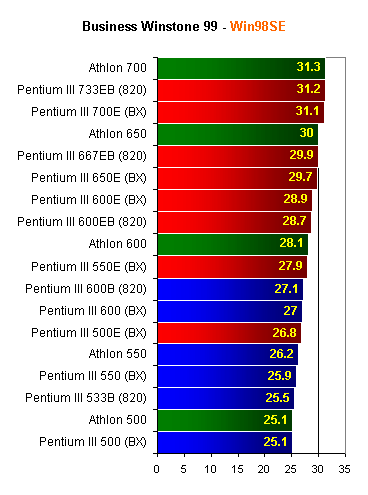
Prior to the release of the Pentium III E, Intel’s fastest CPU, the Pentium III 600B had a difficult time competing with an equivalently clocked Athlon. Once the Pentium III E is factored into the performance equation, the Athlon now has a clock for clock competitor in the business application arena.
The i820 platform does not offer any real performance advantage in business applications as the Pentium III 733EB on the i820 is just as fast as the Pentium III 700E on the BX both of which are virtually identical in performance to the Athlon 700 in business applications.
Business Winstone 99 |
|
Pentium III 733EB (820) |
31.2 |
Pentium III 700E (BX) |
31.1 |
Pentium III 667EB (820) |
29.9 |
Pentium III 650E (BX) |
29.7 |
Pentium III 600EB (820) |
28.7 |
Pentium III 600E (BX) |
28.9 |
Pentium III 600B (820) |
27.1 |
Pentium III 600 (BX) |
27 |
Pentium III 550E (BX) |
27.9 |
Pentium III 550 (BX) |
25.9 |
Pentium III 533B (820) |
25.5 |
Pentium III 500E (BX) |
26.8 |
Pentium III 500 (BX) |
25.1 |
Athlon 700 |
31.3 |
Athlon 650 |
30 |
Athlon 600 |
28.1 |
Athlon 550 |
26.2 |
Athlon 500 |
25.1 |
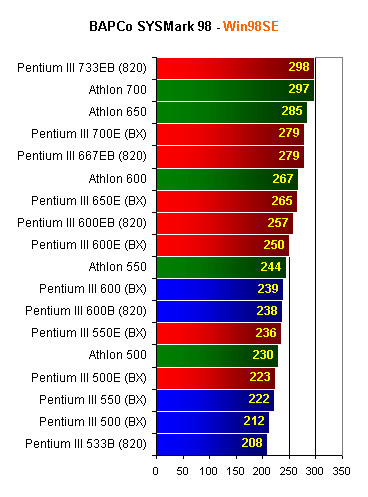
BAPCo’s SYSMark 98 paints a vivid picture of what the overall performance of a system will be excluding any gaming performance tests. The result is that the Pentium III 733EB barely edges out the Athlon 700, offering AMD’s giant the first real competition it has had since its introduction in August.
At lower clock speeds the Pentium III E remains just as competitive although the Athlon generally outperforms it on a clock for clock basis. Once again the benchmarks do not provide a noticeable performance improvement offered by the i820/133MHz FSB platform over the BX/100MHz FSB platform.
The Pentium III E slowly shapes into a viable upgrade path for BX owners looking to squeeze more performance out of their systems without having to upgrade more than just their processor.
SYSMark 98 |
|
Pentium III 733EB (820) |
298 |
Pentium III 700E (BX) |
279 |
Pentium III 667EB (820) |
279 |
Pentium III 650E (BX) |
265 |
Pentium III 600EB (820) |
257 |
Pentium III 600E (BX) |
250 |
Pentium III 600B (820) |
238 |
Pentium III 600 (BX) |
239 |
Pentium III 550E (BX) |
236 |
Pentium III 550 (BX) |
222 |
Pentium III 533B (820) |
208 |
Pentium III 500E (BX) |
223 |
Pentium III 500 (BX) |
212 |
Athlon 700 |
297 |
Athlon 650 |
285 |
Athlon 600 |
267 |
Athlon 550 |
244 |
Athlon 500 |
230 |
Gaming Performance
In order to test the potential gaming performance of the CPUs we used NVIDIA’s recently released GeForce 256. Unfortunately at the time of testing, Athlon CPUs slower than 650MHz were not present in lab and thus their scores have been omitted. Rest assured that we will be conducting a direct comparison between the Pentium III E and the Athlon at all clock speeds in the near future, until then, we apologize for the inconvenience.
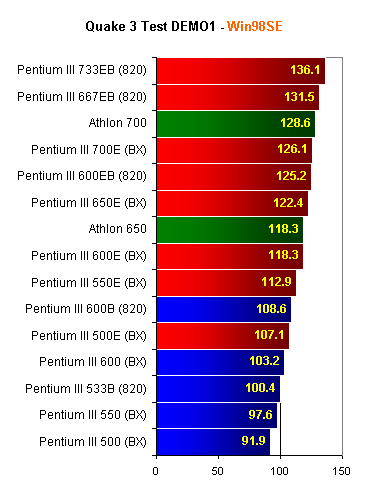
The GeForce seems to enjoy the full speed L2 cache of the Pentium III E in addition to the 133MHz FSB, AGP 4X support, and PC800 RDRAM of the i820 test platform. At 667MHz it steps just beyond the reach of the Athlon 700 but it is worth noting that the Athlon 700 does the same to the Pentium III 700E running on the BX platform.
The combination of the i820 platform and the full speed L2 cache of the Pentium III E definitely make a difference in the gaming performance tests with the GeForce. To satisfy our own curiosity we swapped out the GeForce with an "older" TNT2 Ultra card and found that the Athlon moved up the performance ladder slightly to be directly behind the Pentium III 733 but other than that the changes were minimal.
Both the Athlon and Pentium III E are very capable gaming processors and when armed with a next-generation card such as the GeForce, the performance differences are generally minimal.
Quake 3 - DEMO1 640 x 480 |
|
Athlon 650 |
118.3 |
Athlon 700 |
128.6 |
Pentium III 500 (BX) |
91.9 |
Pentium III 500E (BX) |
107.1 |
Pentium III 533B (820) |
100.4 |
Pentium III 550 (BX) |
97.6 |
Pentium III 550E (BX) |
112.9 |
Pentium III 600 (BX) |
103.2 |
Pentium III 600B (820) |
108.6 |
Pentium III 600E (BX) |
118.3 |
Pentium III 600EB (820) |
125.2 |
Pentium III 650E (BX) |
122.4 |
Pentium III 667EB (820) |
131.5 |
Pentium III 700E (BX) |
126.1 |
Pentium III 733EB (820) |
136.1 |
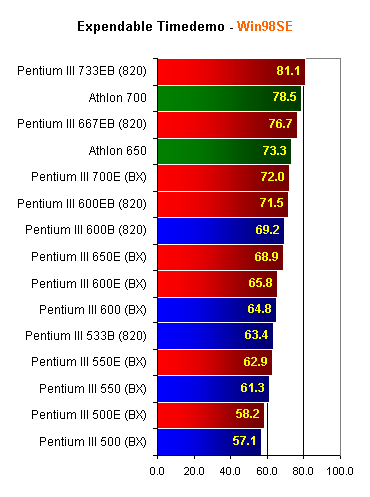
The performance of the Pentium III E here is almost identical to the Q3A benchmarks we just looked at. The effects of the full speed L2 cache are definitely noticeable as are the benefits provided by the i820 platform itself. While they aren’t great, they are definitely present.
Expendable |
|
Athlon 650 |
73.3 |
Athlon 700 |
78.5 |
Pentium III 500 (BX) |
57.1 |
Pentium III 500E (BX) |
58.2 |
Pentium III 533B (820) |
63.4 |
Pentium III 550 (BX) |
61.3 |
Pentium III 550E (BX) |
62.9 |
Pentium III 600 (BX) |
64.8 |
Pentium III 600B (820) |
69.2 |
Pentium III 600E (BX) |
65.8 |
Pentium III 600EB (820) |
71.5 |
Pentium III 650E (BX) |
68.9 |
Pentium III 667EB (820) |
76.7 |
Pentium III 700E (BX) |
72.0 |
Pentium III 733EB (820) |
81.1 |
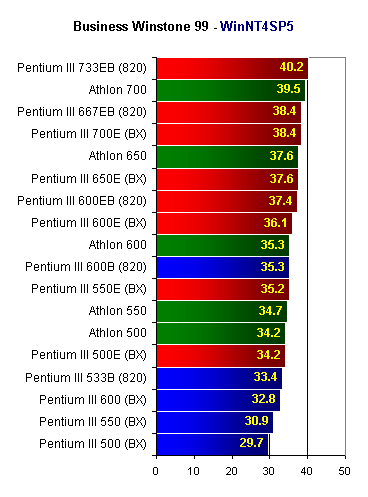
With the help of the 133MHz FSB and PC800 RDRAM Intel’s Pentium III B started to give the Athlon some competition under Windows NT. Of course, this is something we already know from our review of the Pentium III B. At the time, we speculated that an equivalently clocked Coppermine could give the Athlon some competition under Windows NT.
Now, a little over a month later, we are able to see that match up in the flesh. The resulting competition is very close, the Pentium III 733EB just barely edges out the Athlon 700 and the Pentium III 700E falls just a hair behind AMD’s flagship.
In the world of business applications L2 cache speed takes home the gold which is why clock speed matters more to performance than whether or not the CPU is using the 100 or 133MHz FSB setting. Keep this in mind as we take a look at the High-End Winstone 99 results where the rules are slightly different.
Business Winstone 99 |
|
Athlon 500 |
34.2 |
Athlon 550 |
34.7 |
Athlon 600 |
35.3 |
Athlon 650 |
37.6 |
Athlon 700 |
39.5 |
Pentium III 500 (BX) |
29.7 |
Pentium III 500E (BX) |
34.2 |
Pentium III 533B (820) |
33.4 |
Pentium III 550 (BX) |
30.9 |
Pentium III 550E (BX) |
35.2 |
Pentium III 600 (BX) |
32.8 |
Pentium III 600B (820) |
35.3 |
Pentium III 600E (BX) |
36.1 |
Pentium III 600EB (820) |
37.4 |
Pentium III 650E (BX) |
37.6 |
Pentium III 667EB (820) |
38.4 |
Pentium III 700E (BX) |
38.4 |
Pentium III 733EB (820) |
40.2 |

The Athlon’s superior FPU comes in handy in the High-End tests that are centered around FPU intensive applications (i.e. CAD Drafting, Photoshop, etc…) which give the Athlon 700 a 9% performance advantage over the Pentium III 733E. On the "lower" clock speeds it takes the Pentium III 733EB to beat out AMD’s Athlon 600 which gets my recommendation for the best overall performer for the price out of the CPUs compared here.
Although the Athlon is no longer the undisputed champion of the world, it’s superior architecture can easily outpace that of the Pentium III E which is still based on a 3 year old design albeit heavily modified.
An interesting point to make is that the Pentium III 600B (512KB L2 at 300MHz) is actually 3% faster than the new Pentium III 600EB (256KB L2 at 600MHz). This is the perfect real world situation where applications require more than the 256KB L2 offered by the Pentium III E and would benefit with a CPU with a larger although somewhat slower L2 cache.
Intel is hoping to limit the number of cases where older Pentium III CPUs with their larger L2 caches beat out the newer CPUs by limiting the clock speeds of the older CPUs to 600MHz, forcing them to die off as they are ultimately replaced by the newer Pentium III E chips. This is the same thing Intel did with the Pentium Pro and the Pentium II back in 1997. The Pentium Pro’s L2 cache ran at clock speed and often outperformed a higher clocked Pentium II 233 while running at 200MHz. Needless to say the expected release of the Pentium Pro 233 never came along and the CPU quickly died off since it couldn’t compete with the higher clock speed Pentium III processors (300MHz+).
Another point to make is that even if Intel were to allow higher clock speed Pentium IIIs to be released, the current 0.25-micron process seems to max out at around 600MHz meaning that any increase in clock speed would have to follow a tweak of the core itself. Thus we say farewell to the 512KB L2 Pentium II/III design that has been with us for two years now and welcome the new Pentium III E.
High End Winstone 99 |
|
Athlon 500 |
28.5 |
Athlon 550 |
29.3 |
Athlon 600 |
31.7 |
Athlon 650 |
33.3 |
Athlon 700 |
35.1 |
Pentium III 500 (BX) |
25.2 |
Pentium III 500E (BX) |
26.7 |
Pentium III 533B (820) |
28.7 |
Pentium III 550 (BX) |
26.4 |
Pentium III 550E (BX) |
27.8 |
Pentium III 600 (BX) |
27.6 |
Pentium III 600B (820) |
30.8 |
Pentium III 600E (BX) |
28.8 |
Pentium III 600EB (820) |
29.9 |
Pentium III 650E (BX) |
30 |
Pentium III 667EB (820) |
31.1 |
Pentium III 700E (BX) |
30.7 |
Pentium III 733EB (820) |
32.1 |
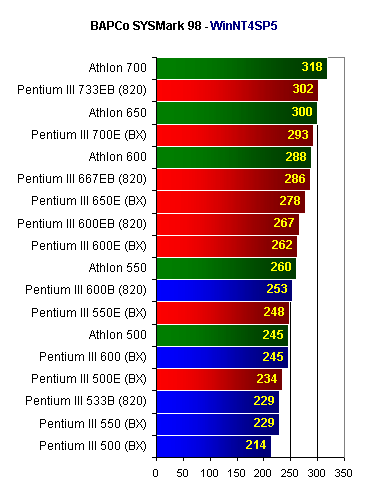
By concentrating on a wide variety of applications, SYSMark 98 is a very good tool for talking about the overall performance of a system. If you use applications that would primarily be considered to be "high-end" (i.e. CAD Drafting, Software Development, Image Editing, etc…) then High End Winstone 99 is the benchmark you need to focus in on. And if you’re primarily a business application user, then Business Winstone 99 would make the most sense for your needs. But as an indication of performance in all arenas (with the exception of games), SYSMark 98 is perfect.
And overall, judging from the SYSMark 98 scores, the Athlon is the faster CPU. At 700MHz, the Athlon weighs in 7% faster than the Pentium III E at 733MHz. This advantage comes mainly from the FPU intensive applications that are a part of the SYSMark 98 suite.
There is also a clearly defined division between the Pentium III EB and the Pentium III E running on the i820 and BX platforms respectively. This supports the argument that the 133MHz FSB & RDRAM do make a difference in overall system performance.
SYSMark 98 |
|
Athlon 500 |
245 |
Athlon 550 |
260 |
Athlon 600 |
288 |
Athlon 650 |
300 |
Athlon 700 |
318 |
Pentium III 500 (BX) |
214 |
Pentium III 500E (BX) |
234 |
Pentium III 533B (820) |
229 |
Pentium III 550 (BX) |
229 |
Pentium III 550E (BX) |
248 |
Pentium III 600 (BX) |
245 |
Pentium III 600B (820) |
253 |
Pentium III 600E (BX) |
262 |
Pentium III 600EB (820) |
267 |
Pentium III 650E (BX) |
278 |
Pentium III 667EB (820) |
286 |
Pentium III 700E (BX) |
293 |
Pentium III 733EB (820) |
302 |

3D Studio MAX is the perfect indication of a situation where the 133MHz FSB is necessary. Limited by the available bandwidth the Pentium III 500 – 600 (BX) fall in the last three places of this comparison. The Athlon 700’s 200MHz EV6 bus and its superior FPU keep it on top of the game but it is beginning to feel the threat posed by the Pentium III 733EB which was just five tenths of a second slower in our render tests.
The 133MHz FSB definitely helps the performance under 3D Studio MAX but the Pentium III E’s full speed L2 cache keeps the 100MHz FSB Pentium III Es competitive in the benchmark.
Clock for clock the Athlon is the faster CPU, but by a much lesser degree than they once were when Intel’s only competition was the lowly Pentium III 600. Another point worth taking notice of is the fact that Intel’s Pentium III 600B is useless now, the Pentium III 500E provides very similar performance at a lower clock speed and the Pentium III 550E provides greater performance at a still lower clock speed. This is while running on the 100MHz BX platform making the Pentium III B (600/533) a completely useless investment now with the release of the Pentium III E.
3D Studio MAX |
|
Athlon 500 |
59.5 |
Athlon 550 |
56.7 |
Athlon 600 |
55.0 |
Athlon 650 |
50.9 |
Athlon 700 |
45.1 |
Pentium III 500 (BX) |
82.2 |
Pentium III 500E (BX) |
63.1 |
Pentium III 533B (820) |
64.0 |
Pentium III 550 (BX) |
77.4 |
Pentium III 550E (BX) |
59.5 |
Pentium III 600 (BX) |
76.2 |
Pentium III 600B (820) |
59.9 |
Pentium III 600E (BX) |
55.8 |
Pentium III 600EB (820) |
54.6 |
Pentium III 650E (BX) |
53.6 |
Pentium III 667EB (820) |
51.1 |
Pentium III 700E (BX) |
51.4 |
Pentium III 733EB (820) |
45.6 |
Conclusion
The Athlon is no longer king of the hill…neither is the Pentium III E. Overall, the Athlon is still the faster chip on a clock for clock basis. It is also the cheaper chip on a clock for clock basis, at least for now. So what do we recommend in this case?
The i820 platform, when it does in fact launch will be quite pricey at first. This is the first signal to stay away from 820 for now at least until RDRAM drops in price and the platform begins to enter the mainstream market. If you absolutely must have a 133MHz FSB Pentium III E (600EB, 667, 733) then the Apollo Pro 133A is a viable option as it also adds support for AGP 4X and when used with VC-SDRAM it can offer overall performance very close to that of the i820 platform.
This leaves two options for Intel based chipset solutions, the old 440BX and the 810E. This also leaves us with warning number two: stay away from the i810E platform as a solution for the Pentium III E. The i810E platform is best suited for the Celeron or other low-cost processors and not the Pentium III E. Just because the i810E supports the 133MHz FSB does not mean that you should pursue it as a possible home for your new Pentium IIIE. But then again, most of you already knew that.
The BX platform seems like it’s going to be around for a little while longer. The big OEMs have already made their minds and are willing to stick with the BX platform as long as i820 isn’t available and they may continue to support the chipset even after the release of i820. This scares Intel quite a bit, because they need the mainstream acceptance of their 820 chipset in order to push RDRAM forward. So what is the end result? Three words: BX chipset shortages. After the release of the i820 don’t expect Intel to be too happy about selling BX chipsets to manufacturers so you can expect the BX to either disappear or increase in cost after the release of the i820.
But what about all of the users that already have BX motherboards? You all are in luck. The Pentium III E provides a direct upgrade path for i440BX users without compromising performance. If, for one reason or another, your Pentium III 600 just isn’t cutting it, or it is time to upgrade from that Celeron 450A combo you purchased a while back, the Pentium III E is available in 5 different 100MHz FSB clock speeds that will work just fine on most BX boards (500/550/600/650/700MHz) and the performance is very respectable. This is probably the most intelligent upgrade path for users looking to purchase the Pentium III E, especially if you already have a BX motherboard. The numbers speak for themselves, the i820 platform does not make a huge performance difference with the Pentium III E (although it is noticeable) and is thus not a requirement for getting good performance out of the processor.
Now what about the Athlon? The Athlon 600 is still my pick for the best performing chip at a fairly reasonable price. It has no problem outperforming most of Intel’s solutions and if you pick up a modified Athlon 600 (we will be reviewing some of these modification options next week) the chances are very good that you’ll be able to hit at least 650MHz (700MHz won’t be too far out of your reach either). But if you already have a BX setup, should you upgrade to the Athlon? Unfortunately the answer is no. The quality of the motherboards available for the Athlon is definitely sub par and if you need a performance upgrade now and already have a BX motherboard, your best bet is to pick up a BIOS upgrade that enables support for the Coppermine core and pick up a Pentium III E.
If you’re building a new computer and the decision comes down to Athlon or Pentium III E, the choice is as close to 50/50 as possible thus leaving it up to you. On the one hand, the Athlon is the faster (clock for clock) and based on much more sophisticated architecture. And on the other hand the Pentium III E has much better motherboard support (even with the BX) and runs considerably cooler.
It’s a tough decision to make but it is good to see that both companies are pushing the bar of competition higher and higher. The match is over for this year, neither manufacturer will push for any new product releases before 2000. The ball is in AMD’s court now, will they be the first to break the 800MHz barrier in 2000? What AMD needs now is to make the move to 0.18-micron as soon as they can to help them push the limits of the Athlon’s architecture. It is possible that AMD will be the first to hit 1GHz but can they keep up with the rate of growth Intel is planning to offer with their 0.18-micron CPUs?
For now it is good to know that we as consumers have two very good options when looking to purchase a desktop computer, the final decision, as always, is up to you. We’re just here to make the ride a little more interesting ;)







